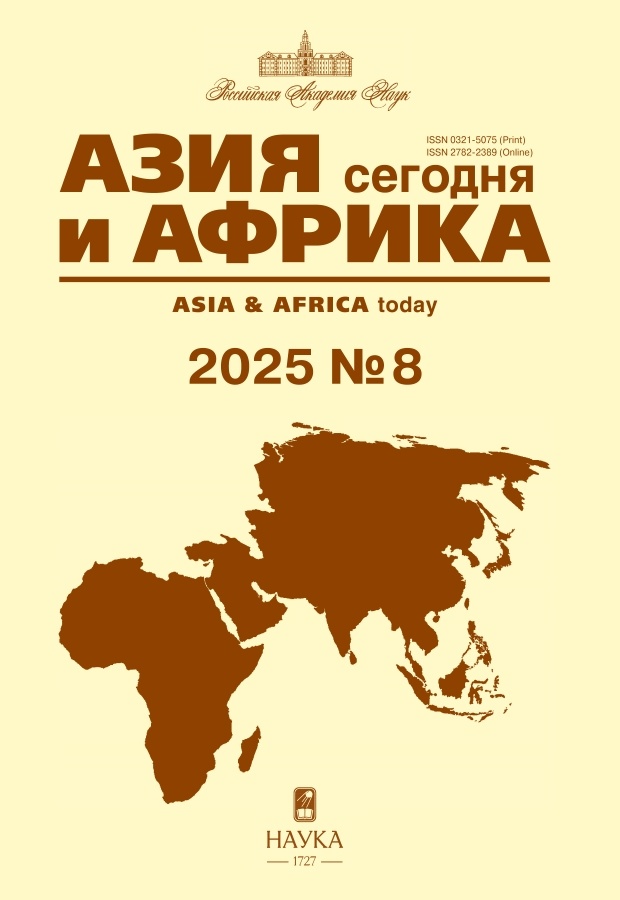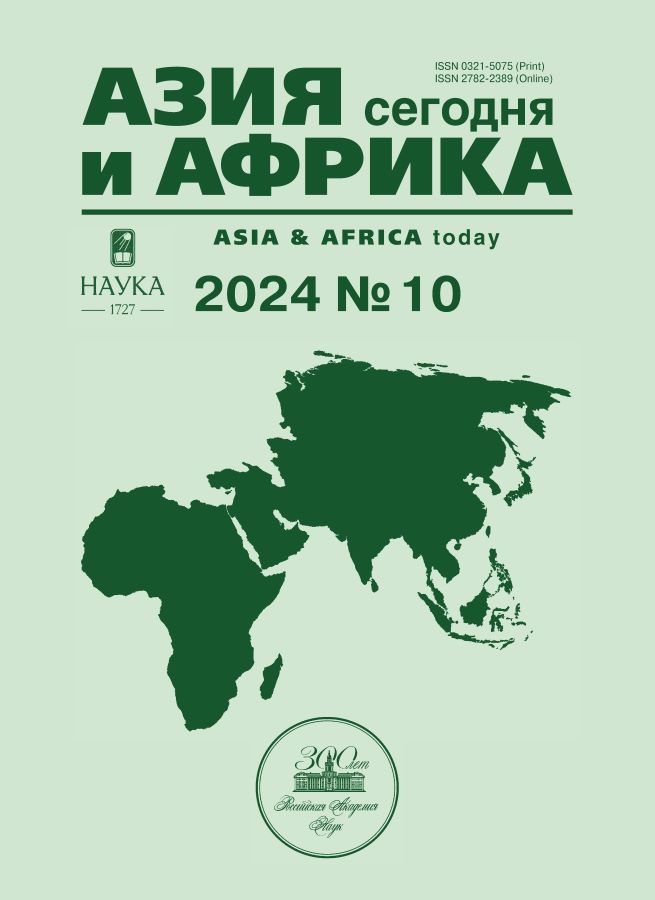Обеспечение чистой водой как фактор эпидемиологического перехода в странах Африки южнее Сахары
- Авторы: Агафошин М.М1, Горохов С.А1, Дмитриев P.B1
-
Учреждения:
- Институт Африки РАН
- Выпуск: № 10 (2024)
- Страницы: 39-48
- Раздел: Политика, экономика
- URL: https://jdigitaldiagnostics.com/0321-5075/article/view/647479
- DOI: https://doi.org/10.31857/S0321507524100057
- ID: 647479
Цитировать
Полный текст
Аннотация
Об авторах
М. М Агафошин
Институт Африки РАН
Email: agafoshinmm@gmail.com
ORCID iD: 0000-0002-0245-0481
кандидат географических наук, старший научный сотрудник, Центр глобальных и стратегических исследований Москва, Российская Федерация
С. А Горохов
Институт Африки РАН
Email: stgorohov@yandex.ru
ORCID iD: 0000-0001-9984-6054
доктор географических наук, профессор, заведующий, Центр глобальных и стратегических исследований Москва, Российская Федерация
P. B Дмитриев
Институт Африки РАН
Email: dmitrievrv@yandex.ru
ORCID iD: 0000-0003-4018-9832
доктор географических наук, заместитель директора по научной работе Москва, Российская Федерация
Список литературы
- du Plessis A. 2017. Global Water Scarcity and Possible Conflicts. In: Freshwater Challenges of South Africa and its Upper Vaal River. Cham: Springer. Pp. 45-62. doi: 10.1007/978-3-319-49502-6-3
- Gulumbe B.H., Yusuf Z.M., Faggo A.A., Yahaya T.O., Manga S.S. 2023. The Interplay Among Conflict, Water Scarcity, and Cholera in Northern Nigeria. Public Health Challenges. Vol.2.Is. 3. doi: 10.1002/puh2.118
- GBD 2021 Forecasting Collaborators. 2024. Global Burden and Strength of Evidence for 88 Risk Factors in 204 Countries and 811 Subnational Locations, 1990-2021: A Systematic Analysis for the Global Burden of Disease Study 2021. The Lancet. Vol. 403. Iss. 10440, Pp. 2162-2203. doi: 10.1016/S0140-6736(24)00933-4
- Roche R., Bain R., Cumming O. 2017. Correction: A Long Way to Go - Estimates of Combined Water, Sanitation and Hygiene Coverage for 25 Sub-Saharan African Countries. PLoS One. Vol. 12. Iss. 3. doi: 10.1371/journal.pone. 0173702
- Prüss-Üstün A., Bos R., Gore F., Bartram J. 2008, Safer Water, Better Health: Costs, Benefits and Sustainability of Interventions to Protect and Promote Health. Geneva: World Health Organization.
- State of the World’s Drinking Water: An Urgent Call to Action to Accelerate Progress on Ensuring Safe Drinking Water for All. 2022. Geneva: World Health Organization.
- Громова О.Б. Субсахарская Африка: угрозы глобального изменения климата. Азия и Африка сегодня. 2018. № 3. C. 56-61.
- Siiba A, Kangmennaang J, Baatiema L, Luginaah I. 2024. The Relationship Between Climate Change, Globalization and Non-Communicable Diseases in Africa: A Systematic Review. PLoS One. Vol. 19. Iss. 2. DOI: 10.1371/ journal.pone.0297393
- Bataliack S., Mbondji P., Saha Tahoum U., Karamagi H. 2024. Atlas 2022 of African Health Statistics: Key Results Towards Achieving the Health-Related SDGs Targets. Health policy OPEN. Vol. 6. doi: 10.1016/j.hpopen. 2024.100121
- Cerf M.E. 2018. The Sustainable Development Goals: Contextualizing Africa’s Economic and Health Landscape. Global Challenges. Vol. 2. Iss. 8. doi: 10.1002/gch2.201800014
- Wolf J., Johnston R.B., Ambelu A., Arnold B.F., Bain R., Brauer M., Brown J., Caruso B.A., Clasen T., Colford J.M.Jr., Mills J.E., Evans B., Freeman M.C., Gordon B., Kang G., Lanata C.F., Medlicott K.O., Prüss-Ustün A., Troeger C., Boisson S., Cumming O. 2023. Burden of Disease Attributable to Unsafe Drinking Water, Sanitation, and Hygiene in Domestic Settings: A Global Analysis for Selected Adverse Health Outcomes. Lancet. Vol. 401. Iss. 10393, Pp. 2060-2071. doi: 10.1016/S0140-6736(23)00458-0
- Царев П.Г. Сотрудничество России и Африки в водной сфере. Ученые записки Института Африки РАН. 2017. № 2. С. 66-76.
- Omran A.R. 1971. The Epidemiologic Transition. A Theory of the Epidemiology of Population Change. The Milbank Memorial Fund Quarterly. Vol. 49. Iss. 4. Pp. 509-538.
- Corruccini R.S., Kaul S.S. 1983. Part 3: The Epidemiological Transition and Anthropology of Minor Chronic Non-Infectious Diseases. Medical Anthropology. Vol. 7. Iss. 3, Pp. 36-50. doi: 10.1080/01459740.1983.9987039
- Omran A.R. 1983. The Epidemiologic Transition Theory. A Preliminary Update. Journal of Tropical Pediatrics. Vol. 29. Iss. 6. Pp. 305-316. doi: 10.1093/tropej/29.6.305
- Weisz G., Olszynko-Gryn J. 2010. The Theory of Epidemiologic Transition: the Origins of a Citation Classic. Journal of the History of Medicine and Allied Sciences. Vol. 65. Is. 3. Pp. 287-326. doi: 10.1093/jhmas/jrp058
- Olshansky J., Ault B. 1986. The Fourth Stage of the Epidemiologic Transition: The Age of Delayed Degenerative Diseases. The Milbank Memorial Fund Quarterly. Vol. 64. Iss. 3. Pp. 355-391.
- Rogers R.G., Hackenberg R. 1987. Extending Epidemiologic Transition Theory: A New Stage. Social biology. Vol. 34. Is. 3-4, Pp. 234-243. doi: 10.1080/19485565.1987.9988678
- Omran A.R. 1998. The Epidemiologic Transition Theory Revisited Thirty Years Later. World Health Statistics Quarterly. Vol. 51. Iss. 2-4. Pp. 99-119.
- Вишневский А.Г. Эпидемиологический переход и его интерпретации. Демографическое обозрение. 2020. № 3. С. 6-50. doi: 10.17323/demreview.v7i3.11635
- Вишневский А.Г., Дмитриев Р.В. Глобальные демографические процессы в XX - начале XXI веков. География мирового развития. Вып. 3 / Под ред. Л.М.Синцерова. М.: Товарищество научных изданий КМК, 2016. C. 197-229.
- Jung M., Jembere G.B., Park Y.S., Muhwava W., Choi Y., Cho Y., Ko W. 2021. The Triple Burden of Communicable and Non-Communicable Diseases and Injuries on Sex Differences in Life Expectancy in Ethiopia. In; J Equity Health. Vol. 20. doi: 10.1186/s12939-021-01516-0
- Murray C.J.L., Lopez A.D. 1996. The Global Burden of Disease. A Comprehensive Assessment of Mortality and Disability from Diseases, Injuries, and Risk Factors in 1990 and Projected to 2020. Cambridge, Massachusetts Harvard School of Public Health Geneva, on behalf of the World Health Organization and The World Bank. DOI: 10. 17226/13533
- Africa’s Water and Sanitation Infrastructure: Access, Affordability, and Alternatives. 2011. Banerjee S.G., Morella E. (eds). Washington D.C.: The World Bank.
- Ursache S-A., Gabor V-R., Muntele I., Maftei M. 2021. Mortality Trends by Causes of Death and Healthcare during a Period of Global Uncertainty (1990-2017). Healthcare. Vol. 9. Iss. 6. doi: 10.3390/healthcare9060748
- Ndayizigiye M., Allan-Blitz L.T., Dally E., Abebe S., Andom A., Tlali R., Gingras E., Mokoena M., Msuya M., Nkundanyirazo P., Mohlouoa T., Mosebo F., Motsamai S., Mabathoana J., Chetane P., Ntlamelle L., Curtain J., Whelley C., Birru E., McBain R., Andrea D.M., Schwarz D., Mukherjee J.S. 2022. Improving Access to Health Services Through Health Reform in Lesotho: Progress Made Towards Achieving Universal Health Coverage. PLOS Glob Public Health. Vol. 2. Is. 11. doi: 10.1371/journal.pgph.0000985
Дополнительные файлы











